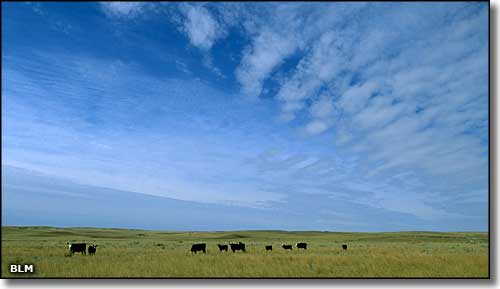 |
|---|
Agricultural Issues - Raising Beef Cattle |
|
|
 |
|
"Cow/calf" and "Yearling" are the two basic types of beef cattle operations. Cow/calf operations are year-round and produce calves as their primary product. In a yearling operation, you purchase weaned calves in the spring, use your summer grazing and sell heavier weight calves in the fall. There are advantages and disadvantages to both. Cow/calf is less financially risky and offer higher returns per animal but they require year-round care. Yearlings are much riskier in that the market prices can shift radically and summer weight gain does not guarantee profit. Cow/calf is the most common type of beef enterprise in southern Colorado. The typical production cycle has cows breeding in late may and June, calving the following February or March and weaning cmplete in August or September. Usually, between 5 and 10 percent of the calves will die between birth and sale. Generally, it takes $150 to $250 per year per cow to cover feed, vet bills, medecine, etc. Calves average 400 to 500 pounds at weaning and sell for $0.85 to $1.00 per pound. Therefore, the average return per cow per year is $140 to $175. Initial investment in the business ranges widely but buying comercially bred cows usually costs $800 to $1200 per head. There is no one right breed of cattle to buy, although you do want to match the breed with the environment. Moderate weight cattle (1000 to 1200 pound mature cows) are the most economical cattle at higher elevations while 800-1100 pound cows are better at lower and dryer elevations. Crossbred cattle are generally superior to purebred cattle because they usually produce a calf that is 5-15% heavier when it is weaned. A yearling operation takes advantage of natural forage throughout the growing season: this is a summer only enterprise. Typically, a yearling operator will purchase 600 pound weaned calves in May and sell them 90 to 150 days later. These calves will generally gain 200 to 250 pounds in 100 days. Working the numbers, yearling cattle have a potential per head return of $30 to $60. The big risks are summer weather and summer price fluctuations in the market. |
|
|
 |
| Index - Arizona - Colorado - Idaho - Montana - Nevada - New Mexico - Utah - Wyoming National Forests - National Parks - Scenic Byways - Ski & Snowboard Areas - BLM Sites Wilderness Areas - National Wildlife Refuges - National Trails - Rural Life Advertise With Us - About This Site - Privacy Policy |
| Upper photo courtesy of the Bureau of Land Management. Text Copyright © by Sangres.com. All rights reserved. |